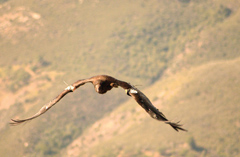
Biologists check on health of young bird monthly
Biologists from Pinnacles National Monument and the Ventana
Wildlife Society recently performed a field check-up on a
California Condor chick, the first wild-hatched condor in San
Benito County in at least 70 years, and determined that the young
bird is doing well.
Biologists check on health of young bird monthly
Biologists from Pinnacles National Monument and the Ventana Wildlife Society recently performed a field check-up on a California Condor chick, the first wild-hatched condor in San Benito County in at least 70 years, and determined that the young bird is doing well.
The collaborative operation between biologists and managers of the private ranch near Pinnacles where the nest is located was carried out without harm to the condors or staff. National Park Service biologists Scott Scherbinski and Alacia Welch were assisted in the 30-foot cliff top descent by Ventana Wildlife Society biologist Joe Burnett.
The biologists reported that the bird, identified as male through blood analysis, appeared normal and in good health. Feathers are developing as expected, and the bird now weighs more than 11 pounds. Adult condors can weigh more than 20 pounds. “Thus far, the nestling appears to be maturing at a normal rate,” said Daniel George, Condor Program Manager at Pinnacles.
Nest checks are being performed by biologists in the condor recovery effort about once per month. A small blood sample is routinely taken during the visits, primarily to test for lead levels. Lab results of 18 micrograms per deciliter indicated the nestling had ingested some lead during the previous month. While the level did indicate exposure to the toxic metal, it was not sufficiently high to prompt emergency treatment. The primary source of lead exposure among condors is spent lead ammunition inadvertently ingested from carcasses.
Operators of the 18,200-acre ranch where the nest is located have required use of non-lead ammunition for several years. Working with the Pinnacles Partnership, the staff at RS-Bar Guest Ranch is making provision for a limited number of visitors to view the nest site. Visitors are escorted to a viewing location in small groups, and visits are designed to ensure no adverse impacts on the birds.
California condors are the largest birds in North America, with wingspans of nine-and-a-half feet. They remain one of the rarest birds in the world, with a current world population of about 350. Eighty-five birds are flying free in California. Pinnacles National Monument was selected as a California condor release area due to documented presence of condors in the area, good cliff nest sites and the large area of intact habitat. Five groups of condors have been released at Pinnacles, totaling 23 birds.
In addition to condor releases at several California locations, flocks are being established in the Grand Canyon area and Baja California. The U.S. Fish and Wildlife Service Recovery Plan aims to eventually establish a sustainable population in California of 150 or more condors with at least 15 breeding pairs.
After more than a century of steady population decline, only 22 California condors remained by 1982, when the remaining wild birds were captured in an attempt to rescue the species from extinction.
Because condors can inadvertently ingest lead bullet fragments from animal carcasses and gut piles left in the landscape, the California Legislature recently outlawed use of lead ammunition for big game hunting and depredation throughout the condor’s range. Further information is available at www.dfg.ca.gov/wildlife/hunting/condor.
The effort to re-establish California condors at Pinnacles is a cooperative endeavor involving the U.S. Fish and Wildlife Service, National Park Service, Ventana Wildlife Society, the Institute for Wildlife Studies, Pinnacles Partnership, and private entities such as the RS Bar Guest Ranch, in collaboration with the California Condor Recovery Team. The San Diego Wild Animal Park, Los Angeles Zoo, the World Center for Birds of Prey in Boise, Idaho, and the Oregon Zoo breed condors destined for wild release.
Further details on the Pinnacles National Monument program are available by visiting the Web site http://www.nps.gov/pinn/ or by calling Daniel George at 389-4486, ext. 255.
Information on Ventana Wildlife Society’s condor recovery efforts are available on the Web at http://www.ventanaws.org/species_condors/ or by calling Executive Director Kelly Sorenson at 455-9514.









